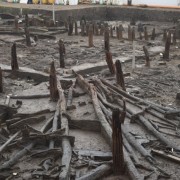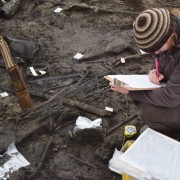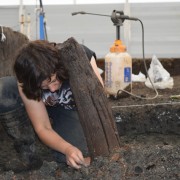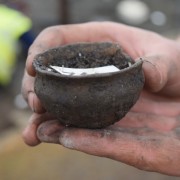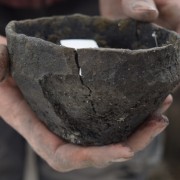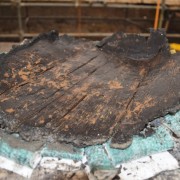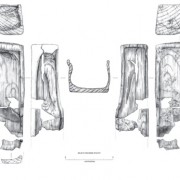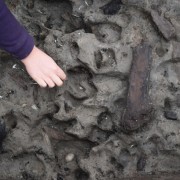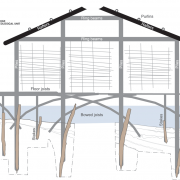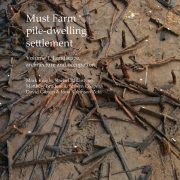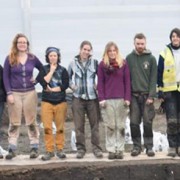Dig Diary 27: Pottery
April 25, 2016
Exploring The Must Farm Pottery Assemblage
In the last few weeks, as we have begun to excavate the collapsed occupation deposits beneath the roundhouses, numerous complete pots and dozens of sherds have started to appear. Pottery is one of the most recognisable and common finds on archaeological excavations. Why is it useful and what can it tell us about life during the Bronze Age? Equally, why are we so excited about the ceramics emerging from the Must Farm excavation and how do they relate to other typical assemblages from this period?
During the 2006 evaluation of the site we found a very comprehensive assemblage of pottery, from a relatively small area of investigation. At the time, it was not clear where this material originated from but now we have exposed the entire area of the surviving settlement, the finds are likely to have come from Roundhouse 5 (RH5). In total, we had pottery from 67 different vessels: 29 of these were either complete, or only slightly damaged. This is a really exciting assemblage, especially from the Late Bronze Age, as domestic pottery from this period is usually fairly heavily fragmented.
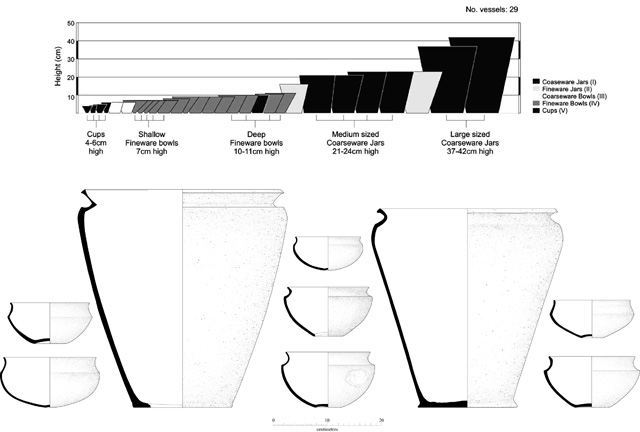
Image showing the completeness of the assemblage recovered from the 2006 evaluation. Vessels of every type feature, from small drinking cups to large storage jars.
As we are removing sediment from the occupation deposits beneath more roundhouses, we are finding even more ceramics including pot sherds and complete vessels. The style and manufacture of all the vessels, including those from 2006, is remarkably similar, almost uniform. The lack of variety in both form and style suggests that all the vessels, ranging from storage jars to cups, was the work of a single potter. This is hugely exciting and represents an assemblage resulting from a potentially short duration.
So, how were these pots created and what materials were being utilised in their production? Pottery from the Late Bronze Age is being created long before wheel-thrown ceramics were manufactured in Britain. This can often come as a surprise, especially given the beautiful and delicate nature of some of the vessels we have, in particular some of the very small drinking vessels. Instead the pots are made using coil building technique: creating rings of clay and stacking them on top of one another to form the shape of the vessel. The pot is then “turned”, by being placed on an object or board and then rotated by hand, using fingers to smooth the vessel. We have some very tactile traces of this activity on some of the sherds and vessels, where small lines from the potter’s fingerprints are left on the surface of the pot.
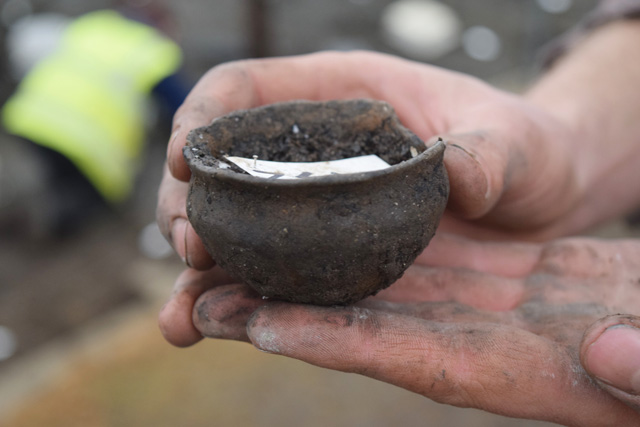
Photo of one of the smallest vessels. Notice the thin walls of the pot and evenness of the shape which were created using a combination of simple coil building and “turning”.
Our assemblage, like most prehistoric examples, is a mixture of coarsewares and finewares. Coarsewares are more “rough and ready” pots, designed for everyday use as storage containers and cooking vessels. The examples from our assemblage have very thick walls and have grog, crushed fired clay, and shell added to them to help with the firing process of the fabric. Adding additional materials to the clay used to create the vessel is a process known as tempering and is a common element of prehistoric pottery manufacture.
The finewares from the site are particularly impressive and have thin walls, many were also burnished or polished. Only a handful had decoration which consisted of simple line incisions near the rim of the vessels. The fineware pots were also tempered with sand or very fine shell fragments. It is possible these crushed shells may have originated in the river that the stilted houses were built above. We also suspect that the clay used to create the pots originated from relatively close to the site, however more detailed analysis will be required to confirm this.
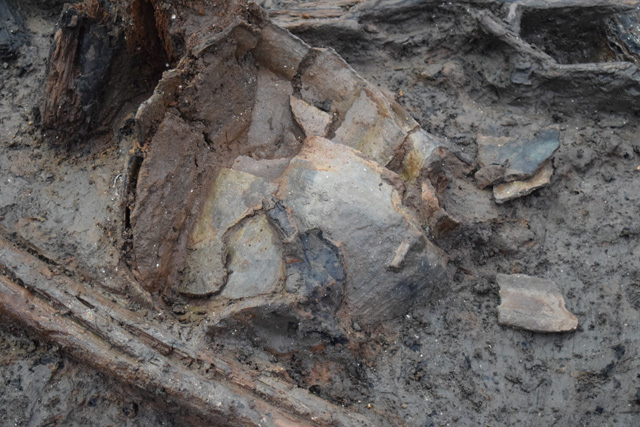
Image of broken, large coarseware vessel. These jars tended to fall into the river sediments and land on their side, resulting in them breaking as a result of the weight of the sediment as it accumulated.
One of the most interesting aspects to our assemblage is ratio of coarsewares to finewares. Most Bronze Age sites have a much larger quantity of coarseware pots than finewares. This makes sense as coarseware vessels are more likely to break, as they would have been used more often and for rougher activities than their fineware counterparts. However, at Must Farm there is a greater number of fineware vessels presenting an unusual contrast with most sites. Perhaps this is an indicator that the site had its lifespan cut short.
Alongside complete vessels, we are recovering a lot of pottery sherds of both finewares and coarsewares. Many of the coarseware sherds seem to have occurred from breakages of the vessels resulting from use. The deposition of these broken coarseware fragments seems to be around the outside of the roundhouses. This strongly suggests that the fragments were dumped over the sides of the houses and into the river as a means of disposing of them.
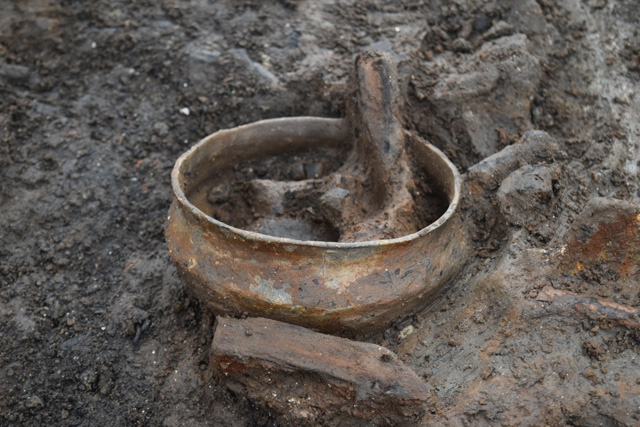
A typical fineware bowl in the process of being excavated.
Contrastingly, the fineware fragments all seem to have broken as a result of the fire rather than through use during the occupation. The intensity of the heat of the blaze caused many of these more fragile pots to spall, a phenomenon that occurs when pieces of ceramic explode and separate from the body of the vessel. Other finewares cracked when the “thermal shock” of suddenly going from hot to cold happened as the pots fell into the water of the river below.
One of the unique and exciting opportunities that the Must Farm ceramic assemblage gives us is the ability to gain insights into the fire inside the building. As the vessels were all inside the building at the time of the blaze, many display evidence of the temperatures they were subjected to. Carefully examining the exteriors of the pots shows areas of intense spalling, scorching and soot marks. These markings can potentially help us get a glimpse inside the buildings as they burned, possibly even allowing us to estimate their approximate heights and positions in the home.
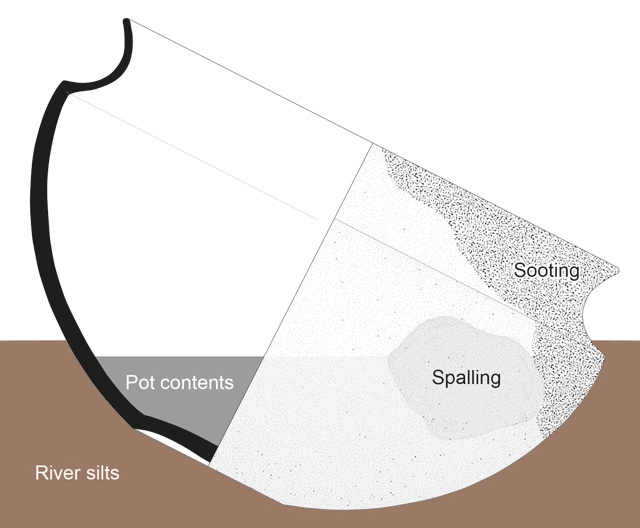
Diagram showing how vessels can come to rest in the river sediments. Note the positioning of the sooting and spalling, which is likely to reflect where the pot was positioned in the structure. The pots contents often come to rest at odd angles; a result of the vessel falling unevenly into the silt.
However, these kind of calculations and investigations are far from straightforward and complicated by the deposition of the vessels. The fact that the pots are not in situ, having fallen through the floor of the buildings into the river channel, means that they could have moved slightly from their initial positions. As explained in the last diary entry, it is unlikely the finds moved far owing to the stillness and shallowness of the river.
The resting place of the vessels on the bottom of the channel can result in some of this information being lost. The gradual wear of the water flowing, slowly, over the pots can remove soot and scorch marks. In some cases, this process of wear has even removed the burnish on the side of some vessels! Yet, despite these complications we are hopeful to glean more information about the fire itself from the examination of the condition of the vessels.
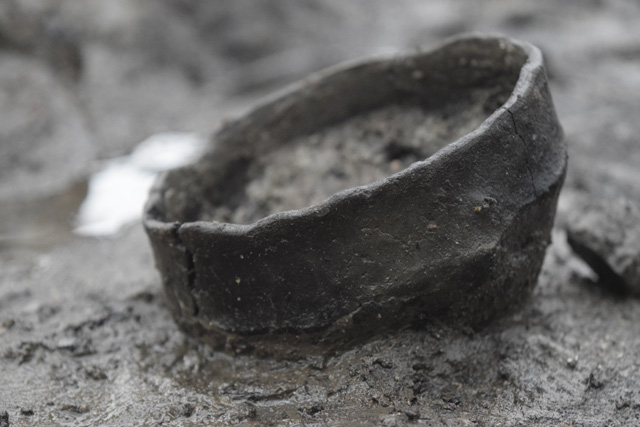
Complete pot, slightly “coarser” than other examples from the site.
Pottery is undoubtedly one of the important artefact types from prehistory and will help us to build a much more accurate understanding of the settlement. One of the most exciting prospects will be when we get to see the entire assemblage. Will there be a similar number of pots in each house? If there isn’t, does this mean some homes had more people living inside? Will the types and quality of vessel be the same for each house? If this isn’t the case, will some buildings have superior or inferior quality pots? There are dozens of questions we can ask, and hopefully answer, about the ceramics from Must Farm. With so many complete vessels and sherds appearing each week, we cannot wait to get started looking into the pottery in more detail!
Related stories
Dig Diary 27: Pottery
April 25, 2016
Dig Diary 26: Exploring Inside a Bronze Age Home
April 18, 2016
Dig Diary 25: Wooden Objects
April 11, 2016
Dig Diary 24: Visualising the Site
April 4, 2016
Dig Diary 23: Footprints and Posts
March 28, 2016
Learn more
About
The Must Farm pile-dwelling settlement was excavated by the Cambridge Archaeological Unit with funding from Historic England and Forterra.Publications
Read the Open Access publications the Must Farm pile-dwelling settlement: Volume 1. Landscape, architecture and occupation and Volume 2. Specialist reports.Post-Ex Diaries
Our work on-site has finished but lots more investigation is taking place as we study both the material and the evidence we recovered. ...read more
Discoveries
See some of the discoveries from the Must Farm pile-dwelling settlement.
Making Must Farm
Find out about our work with AncientCraft recreating Must Farm’s material.
FAQs
Further information on the Must Farm project.

